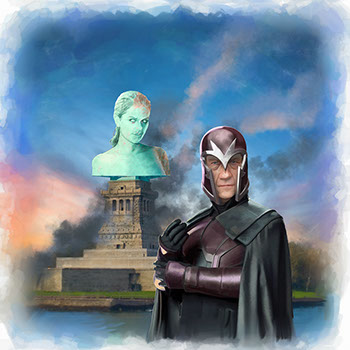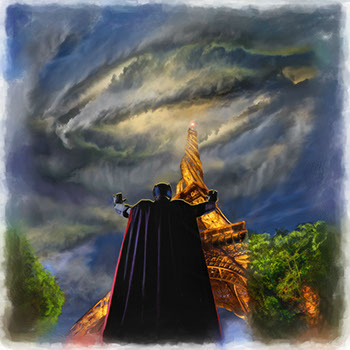
Instead of The Days of Future Past being an X-Men First Class movie with Wolverine and cameos, imagine if it was a direct sequel to X-Men III: The Last Stand, where an older Rogue returns to the past and the time of the original X-Men movie...
On the night of Bobby and Marie's wedding, she learns the "cure" she took in The Last Stand wasn't permanent, as we know from the Magneto sequence. As we also know, powers manifest during moments of great emotion and passion. On the night of her wedding, she kills Bobby Drake while making love. Flash forward 15 years, and Rogue has plenty of reason to return to the past... but are her motives entirely clear?
This was designed as the first of a new trilogy featuring the original X-Men cast while a concurrent First Class set of movies would have taken place in
the 1960's. Fox chose to go
forward exclusively with the
First Class group and move into
the 1970's and now 80's.

By returning to the period of events of Liberty Island, we were able to address several things. First, we reveal that the Phoenix isn't what it appeared to be in the third movie, but is, in fact, an alien force parasite inside Jean Grey. When Rogue gets her alone in Cerebro, an epic battle ensues between the future powered Rogue and the Phoenix, now fully revealed!
By having Rogue be our main time traveler, we actually get to see her interact with our heroes at her proper comics age. Her flirting with Wolverine is no longer a little creepy... We also get to see Rogue after she has been through Hell and done some things she regrets, resulting in a powerful woman as we've never seen her before.
Marie/Rogue was established as the main character of this franchise. We saw no reason to abandon that.
After she accidentally kills Iceman on their wedding night, Rogue turns to a scientist named Forge, who actually believes she is the key to a cure for the Mutant Factor. Unfortunately, he's right. 15 years later, it's detention camps, slaughter, everything Magneto warned against.
Only Rogue and Forge know the true extent of her mission to the past. The others believe it's only to save Senator Kelly from Magneto's dastardly device and purge the Phoenix Force from Jean Grey. It isn't. Her mission is to also let Magneto succeed in killing her younger self and prevent the cure from ever happening.
We use several sequences from the original film, but things go very differently once Magneto arrives unfettered at Liberty Island.
After that opening act, we move forward 10 years in this new reality. In the interim, Genosha has become a haven for mutants. It is also a front for the experiments of Doctor Nathaniel Essex. When Magneto realizes his research is the key to his own mutant making monstrosity working, he pays the good doctor a visit.
Once equipped with the means to transform Homo sapiens into Homo superior safely, his plan is to go to the place where he can make the most impact with a single stroke. Paris is his canvas, and the Eiffel Tower itself becomes the brush, as he twists it into one of his diabolical machines. All of Paris is at risk of being made mutants in an instant.
Only the X-Men can face off against the Master of Magnetism in one half of the epic conclusion of this movie.
The other, and certainly more dangerous threat to mankind as a whole are the Sentinels and Master Mold. In the opening of the film, Master Mold is merely a mothballed project in the bowels of government storage... until he senses Forge's time portal being tested. Sending a signal into the past along with Rogue and Bishop, the Master Mold will not be content being a scuttled project.
In the decade since the initial time incursion, Bolivar Trask has successfully lobbied the Defense Department and President Kelly, whose reaction wasn't what Rogue had hoped, for the somehow properly working Master Mold project to go forward. Sentinel construction is well underway.
Of course, not even dear Bolivar understands the plan. Then again, does the Master Mold?
Our approach to the screenplay was to not ignore any of the X-Men film material that had come before. If there were two Moira's, then there are two Moira's. Although she hit our cutting room floor, the Moira MacTaggart shown in The Last Stand would've been revealed as the daughter of Xavier and Rose Byrne's Moira from First Class.
It was also our intention to fully use the heroes and villains, not simply have them show their powers a couple times and die or go away, a common complaint of X-Men movies. We believed we could keep up the action, but also add significant character beats for each of our people. From the dystopian future, Genosha, to our Paris and Master Mold sequences, we feel we have a perfect balance of character and action. Also, because we had planned it out as a trilogy, there were Easter Eggs.
Throughout the movie we set up our next chapter. In fact, it is the time travel of Rogue and Bishop itself that awakens Apocalypse.
In the last image above, you can see part of the setup for the next movie, as Angel has his wings clipped. Our X-Men V: The Four Horsemen, would've dealt with the impending rise of Apocalypse. Through his minion, Mister Sinister, he would have sought out and distorted mutants to his own end. This fight would have culminated in X-Men VI: Apocalypse, wherein Bishop returns, only to be seemingly opposed by another mysterious time traveler named Cable. And that's when we would've united the original group and the First Class cast.
Although they went a different way, we still think our screen play is a fun read. Click here and enjoy!
©2016 Third Triumvirate Studios
At Third Triumvirate Studios, our ambition is to build worlds which will inspire as well as entertain, and to populate them with memorable, fully developed characters. We aspire to bring to our audience a sense of fun, to make something truly engaging that rekindles the flame of imagination in the old and adds fuel to the fire in the young.












